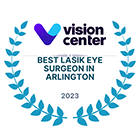
Blurred vision, increased sensitivity to light, or difficulty seeing at night—these can be more than just signs of aging. Cataracts often develop gradually, making it easy to ignore the early symptoms. However, delaying evaluation by a cataract specialist can impact your daily life and vision clarity. At Silk Vision, with Dr. Silk’s expertise, timely diagnosis and personalized care ensure optimal outcomes. Learn more about when it's time for professional care and how cataract surgery and removal can restore your vision.
Frequent Changes in Prescription Glasses or Contacts
Have you noticed that your prescription glasses or contact lenses seem to need frequent adjustments? While minor vision changes can be normal as we age, repeated shifts in your prescription could be a sign of cataracts. These changes often sneak up gradually, making it all the more important to pay attention and take action when needed.
Why Your Vision Keeps Changing
When cataracts start to form, they cloud the lens of your eye, disrupting its ability to focus light clearly onto the retina. This constant interference means your vision doesn’t stay stable, leading to the need for frequent updates to your prescription. Think of it like trying to see through a foggy window; no matter how much you adjust your perspective, the view remains unclear.
If you've noticed you're replacing glasses or contacts more than usual, it might not just be natural aging. It could be the result of cataracts altering the way your eye refracts light. This is a good time to consult a cataract specialist, like Dr. Silk at Silk Vision, to pinpoint the root cause and explore solutions.
Link Between Cataracts and Vision Blurriness
Blurred or fluctuating vision is a hallmark symptom of cataracts. At first, you might dismiss it as tired eyes or poor lighting, but over time, these changes become harder to ignore. Cataracts create a clouding effect, scattering light as it passes through the lens. This not only makes your vision blurry but also causes colors to appear less vibrant and clear.
It's more than just an inconvenience—it’s a signal to act. Blurry, changing vision may indicate advancing cataracts that need attention. Scheduling a consultation with a cataract specialist can confirm whether cataracts are the culprit and what steps you can take. In many cases, cataract surgery and removal is a reliable way to restore clear sight and halt the cycle of prescription changes.
Difficulty Seeing at Night
One of the most disruptive signs of cataracts is difficulty seeing at night. If nighttime activities like driving or even walking in dimly lit areas have become a challenge, it may be due to the clouding over your eye’s lens. Cataracts scatter and block light, making dark environments particularly tough to navigate.
Challenges with Driving at Night
Driving at night with cataracts can feel daunting. The glaring headlights from oncoming cars may seem overly bright or create a starburst effect. Additionally, cataracts reduce contrast sensitivity, making it difficult to distinguish objects from their background in low light. Have you noticed road signs or street markings becoming harder to read after sundown? These are common struggles for those dealing with cataracts.
Night driving relies on our eyes’ ability to adapt quickly to changing light conditions, but cataracts slow this adjustment. This significantly increases the risk of accidents—so if nighttime driving feels unsafe, it’s worth consulting a specialist.
How a Cataract Specialist Can Help
A cataract specialist can identify the root causes of your night vision troubles through a comprehensive eye evaluation. Specialists like Dr. Silk at Silk Vision will assess your symptoms, determine how cataracts are affecting your sight, and recommend effective treatments. In many cases, cataract surgery and removal can restore clear vision and dramatically improve your ability to see in dark or dim lighting.
If nighttime activities feel increasingly frustrating or unsafe, don’t wait to seek professional help. With personalized care and advanced techniques, a specialist can work with you to regain confidence in your vision and reduce challenges that disrupt your quality of life.
Increased Sensitivity to Light and Glare
Increased light sensitivity can disrupt daily life. For those with cataracts, this often goes beyond a minor inconvenience. Bright sunlight, headlights, or even indoor lighting can become overwhelming, leaving your eyes feeling strained and uncomfortable. If these symptoms sound familiar, it may be time to consult a cataract specialist.
Impact of Light Sensitivity on Daily Activities
Cataracts can make everyday tasks, such as taking a walk outdoors, unnecessarily frustrating. Bright sunlight suddenly feels harsh, almost blinding, making it difficult to enjoy activities like hiking or outdoor sports. Simple errands, like driving during the day, may be interrupted by the glare bouncing off windscreens or buildings.
Indoor activities are not off the hook either. Artificial lighting, especially fluorescent lights, can cause discomfort or headaches due to the heightened sensitivity. Over time, you might find yourself avoiding these situations altogether. This doesn’t have to become your “new normal.” Increased light sensitivity is a key sign that a cataract specialist, like Dr. Silk at Silk Vision, should evaluate your eyes.
Treatment Options for Light Sensitivity
Thankfully, cataracts, and the light sensitivity they cause, are treatable. The most effective solution for long-term relief is cataract surgery. This procedure involves replacing the cloudy lens with a clear artificial one, restoring your ability to tolerate light comfortably. The transformation in how you experience light can be life-changing.
If surgery feels like a big step, your ophthalmologist may initially recommend wearing sunglasses with UV protection or installing anti-glare coatings on your glasses. However, these solutions only mask the symptoms. For lasting clarity and comfort, surgical removal of cataracts is the definitive answer. At Silk Vision, Dr. Silk ensures the process is tailored to your needs, making the transition smooth and effective.
Colors Appearing Faded or Yellowed
Colors that once seemed vibrant and clear now feel dull, lifeless, or even yellowed. This specific change in your vision isn’t just a trick of the eye; it’s often one of the most noticeable signs of cataracts. Colors may lose their richness, making familiar environments appear washed-out or tinted in yellow. Understanding the cause behind this shift can help you take the first step toward restoring your vision.
Understanding the Yellow Tint
Cataracts form when proteins in the natural lens of the eye clump together, creating a cloudy film. This not only scatters and blocks light but also changes the way your eye perceives color. Think of it like a windowpane covered with amber-tinted film that dulls and distorts everything you see. The yellowing effect results from the cataract absorbing more light in the blue spectrum, reducing color contrast and brightness.
Day-to-day, you might find white walls appear beige or your favorite photo has lost the crisp detail you once admired. If reading, matching clothing colors, or enjoying nature feels “off,” the cause may be your lens filtering out colors inaccurately. These changes typically worsen over time, making early detection crucial.
Restoring Vibrancy Through Cataract Surgery
The good news? Cataract surgery can replace your clouded, yellowing lens with a clear artificial one, effectively bringing vibrancy back into your vision. After treatment, many patients are amazed by how vivid and lifelike their world becomes again. That once-muted blue sky? It regains its brilliant hue. The rich greens of your garden? They'll seem as lively as ever.
At Silk Vision, Dr. Silk specializes in personalized cataract care, ensuring every patient experiences the fullest vision restoration possible. By opting for cataract surgery and removal, you’re not just treating the cloudiness but reclaiming your ability to see colors clearly. A simple yet impactful procedure can restore the richness and clarity you might not even realize you've been missing.
Double Vision in a Single Eye
Double vision in one eye, also known as monocular diplopia, is a troubling symptom that often disrupts daily life. Unlike typical double vision, which affects both eyes and is usually linked to alignment issues, monocular double vision stems from problems within the affected eye itself. Cataracts are a common culprit, and addressing this symptom with the help of a cataract specialist could be crucial to preserving your vision.
How Cataracts Cause Double Vision
Cataracts develop when the natural lens of the eye becomes cloudy, disrupting how light passes through to form images on the retina. In cases of monocular double vision, the cloudy lens scatters light, causing it to hit multiple points on the retina. This scattering can lead to overlapping or duplicated images, creating a shadowy, disorienting effect.
Imagine trying to read a book with wax paper laid over one lens of your glasses—it’s not just blurry but frustratingly distorted. Many people notice double vision first in low-light situations, where contrast is already reduced. It’s a clear sign that the lens is losing its transparency and even small daily tasks, like reading or driving, can become strenuous.
This condition can worsen as cataracts progress, so recognizing it early is essential. If you’ve started noticing double vision in just one eye, a simple consultation with a cataract specialist could pinpoint the issue and set you on the path to clearer vision.
Why You Should See a Specialist Immediately
Double vision isn’t just uncomfortable; it can also signal significant lens deterioration. If cataracts are the cause, untreated symptoms often lead to further complications. As the lens becomes more opaque, it decreases overall visual clarity and can lead to permanent vision loss if not addressed timely.
Delaying treatment can have consequences that go beyond your eyesight. Everyday tasks like driving, cooking, or even walking in crowded places may feel increasingly unsafe. Cataract surgery, a straightforward procedure to replace the damaged lens, can completely resolve monocular double vision and restore clarity.
If this symptom sounds familiar, consulting a cataract specialist, like Dr. Silk at Silk Vision, is critical. Through cataract surgery and removal, patients often regain not only clear sight but also their confidence and ability to enjoy life without disruptions from vision problems. Don’t let double vision hold you back—address the issue head-on with expert care.
Seeing Halos Around Lights
Do you ever notice glowing rings or halos around lights, especially in dim or dark environments? Seeing halos can be more than an occasional distraction—it’s often one of the earliest signs of cataracts. This visual distortion happens when the clouded lens scatters light as it enters the eye, creating the illusion of halos encircling bright sources of light. These symptoms might feel like a minor inconvenience at first but can have a significant impact on your everyday activities.
Halos and Their Impact on Driving Safety
Driving at night can become particularly unsafe when halos are part of your vision. Headlights from oncoming traffic and streetlights amplify the effect, creating a glare that makes it difficult to judge distances or see clearly. This can feel like trying to navigate through a maze of blinding orbs, leading to hesitation and discomfort behind the wheel.
Halos often pair with increased light sensitivity and reduced contrast, leaving you unable to discern important details like road signs and lane markings. These challenges can not only disrupt your confidence as a driver but also pose serious safety risks. If you’ve found yourself avoiding nighttime driving or feeling overly cautious due to halos, it may be time to consult a cataract specialist.
Surgical Solutions for Halos
The good news is that these disturbing halos caused by cataracts can be eliminated effectively through surgery. Cataract surgery involves removing the cloudy lens and replacing it with a clear artificial lens, restoring your ability to process light properly and see without distortions. For many patients, this procedure is life-changing, allowing them to drive, enjoy evenings out, and live without the constant stress of visual disturbances.
At Silk Vision, Dr. Silk specializes in advanced cataract treatments tailored to your unique needs. A consultation can help determine if cataracts are causing your symptoms and whether cataract surgery and removal is the right solution for you. Don’t let halos keep you from living fully—clear vision is just a step away with expert care.
Cloudy or Blurry Vision
Experiencing cloudy or blurry vision can feel like looking through frosted glass—a frustrating and sometimes alarming change. Often, this symptom indicates cataracts, as the condition impacts the eye’s natural lens. If left untreated, routine activities like reading, driving, or even recognizing faces can become increasingly difficult.
Progression of Cloudiness in the Lens
Cataracts develop when proteins within the lens of the eye clump together, creating a cloudy area that interferes with light passing through. This progression typically starts small. At first, you may barely notice the difference, but as the opacity spreads, sharpness and clarity in your vision continue to decline.
The lens, which is normally clear, begins to act like a fogged-up windowpane. This not only blocks light but also scatters it, making everything you see appear dim or blurred. Over time, the opacity worsens, which is why cloudy vision is a hallmark sign that you may need to consult a cataract specialist. Addressing these changes early can improve your quality of life and prevent further frustration.
When Cloudiness Becomes a Daily Obstacle
For many, cataracts start as a minor annoyance but quickly escalate into a significant disruption. Tasks that once seemed second nature—like reading menus, completing work on a computer, or enjoying outdoor hobbies—may feel insurmountable. Even recognizing faces or following conversations in group settings can become challenging as your vision deteriorates.
Beyond everyday inconveniences, blurry vision can also affect your productivity and safety. Imagine trying to drive while struggling to see road signs or judge distances. Such circumstances can leave you feeling dependent and unsure.
Fortunately, with the guidance of a cataract specialist, a personalized treatment plan can alleviate these challenges. Procedures like cataract surgery and removal can clear the path to sharper, more functional vision. If cloudy or blurry sight disrupts your routine, it’s time to consider professional evaluation.
Difficulty Reading or Seeing Fine Details
Struggling to focus on printed text, follow the lines of a book, or distinguish fine details? This symptom can start subtly but eventually interfere with daily tasks like reading, sewing, or even recognizing faces. Often, this difficulty stems from cataracts, which cloud the eye’s natural lens and reduce visual precision. If you're noticing these challenges, it might be time to consider consulting a cataract specialist.
How Cataracts Obstruct Clarity
Cataracts develop when proteins inside your eye’s lens naturally clump together, forming opaque areas that block light from passing through clearly. This disrupts the eye’s ability to produce sharp images, making fine details look blurred or distorted. Over time, even with glasses or increased lighting, focusing on intricate work or reading small prints becomes a struggle.
Imagine staring through a foggy camera lens—it’s frustrating and limits your ability to enjoy activities that require fine focus. While you might initially compensate by increasing font size or using stronger light, these temporary fixes can’t address the root cause. Cataracts progressively worsen, making detailed tasks harder and more frustrating over time.
Ignoring this symptom may mean allowing cataracts to continue compromising your quality of life. Early detection can help prevent unnecessary discomfort and safeguard your ability to engage in the activities you love.
The Role of a Cataract Specialist
Seeing a cataract specialist as soon as you notice persistent difficulty reading or spotting fine details is essential. Specialists like Dr. Silk at Silk Vision are trained to evaluate and treat cataracts effectively. Their goal? Restoring your clear vision, so you don’t have to struggle with day-to-day tasks.
Timely intervention can help halt further vision impairment and open the door to life-changing treatments like cataract surgery. This simple yet transformative procedure replaces the clouded lens with a clear artificial one, giving you back the ability to see fine details and small text without the extra strain.
If your blurred vision has made reading or other detailed activities a challenge, reaching out for a professional evaluation can make all the difference. Dr. Silk’s approach to cataract surgery and removal focuses on personalized care tailored to meet your unique needs. There’s no need to live with impaired vision when a specialist can help restore clarity and confidence.
Frequent Eye Strain or Fatigue
Experiencing persistent eye strain or fatigue can be more than just a side effect of binge-watching your favorite show or spending hours at a desk. For many, it may be an early sign of cataracts, a common condition that clouds the lens of the eye and impacts the way you focus.
Cataracts and Eye Overexertion
Cataracts make focusing on objects increasingly difficult because they interfere with the lens’s ability to transmit light clearly. As the lens becomes cloudier, your eyes need to work harder to compensate for the blurriness. Over time, this extra effort leads to constant strain and fatigue, even during routine tasks like reading or driving.
Think of it like running with weights tied to your legs; eventually, you’ll feel the exhaustion. If you find yourself frequently rubbing your eyes, adjusting your screen brightness, or taking more breaks to rest your vision, it could be more than just tiredness. Cataracts are often the underlying cause, silently worsening the problem.
Seeking Relief Through Treatment
A cataract specialist can assess the root cause of your eye strain and fatigue through a detailed eye exam. At Silk Vision, Dr. Silk understands that every case is unique. By diagnosing cataracts early, a personalized treatment plan can be developed to alleviate your discomfort and restore your vision clarity.
In most cases, cataract surgery and removal is the best long-term solution. The procedure replaces your clouded lens with a clear artificial one, relieving your eyes from the constant strain of trying to focus through a foggy surface. Patients often report feeling an immediate reduction in eye fatigue and a significant improvement in overall visual comfort.
If eye strain has become a recurring issue, don’t wait to address it. A consultation with Dr. Silk could be your first step toward lasting relief and sharper vision.
Decreased Vision in Bright Environments
For individuals with cataracts, bright environments can transform from inviting to overwhelming. This isn't merely a discomfort—it's a sign that your eyes are no longer processing light as efficiently as they once did. Whether it's sunlight, high-powered indoor lighting, or reflections off shiny surfaces, these visual challenges could indicate that it's time to consult a cataract specialist.
Why Brightness Hampers Vision for Cataract Sufferers
Cataracts develop when proteins in the lens of your eye clump together, forming a cloudy layer that blocks and scatters light. This cloudiness directly disrupts how light travels to your retina, causing glare, halos, and reduced contrast. Think of it like trying to look directly at a bright spotlight through fogged glass—the glare becomes overwhelming, and your ability to focus diminishes.
Rather than light being evenly distributed across your field of vision, it gets scattered, creating visual distortion. This effect often worsens in bright conditions, like walking outside on a sunny day or driving during peak daylight hours. For many, even adjusting to a brightly lit room indoors becomes a challenge, leading to discomfort and a frequent desire to avoid such environments.
These symptoms not only interrupt daily activities but can also indicate the progression of cataracts. If you’ve noticed increased glare or difficulty seeing clearly in bright settings, it's a sign that your lenses are no longer functioning optimally.
Improving Vision Post-Cataract Surgery
The good news? Cataract surgery can dramatically alleviate these symptoms, providing a clear view and restoring your comfort in brightly lit spaces. During the procedure, your cloudy natural lens is replaced with a clear, artificial intraocular lens (IOL). This replacement eliminates the scattering and blocking of light, immediately improving how your eyes process brightness.
After cataract surgery, patients often report feeling a profound difference—not just in reduced discomfort but in an enhanced ability to see fine details even in harsh lighting conditions. Imagine stepping outside on a bright sunny day and actually enjoying the sunlight without squinting or retreating to a shady spot.
For those dealing with decreased vision in bright environments, scheduling an evaluation with a cataract specialist is the first step to relief. Don’t let sensitivity or decreased clarity hold you back. Reach out to a trusted provider like Dr. Silk for expert care and explore your options for lasting visual improvement. With advanced techniques in cataract surgery and removal, restoring your ability to enjoy bright environments is entirely possible.
Conclusion
Recognizing the signs that it’s time to see a cataract specialist is essential for safeguarding your vision and quality of life. Common symptoms like blurry vision, increased light sensitivity, or difficulty seeing at night shouldn’t be ignored. Early diagnosis allows for effective treatment, often preventing further complications.
At Silk Vision, Dr. Silk specializes in personalized cataract care, offering treatments that can restore clarity and make everyday tasks easier again. Don’t wait for symptoms to worsen. Contact Silk Vision today for a consultation and take the first step toward clearer vision. For more details, explore cataract surgery and removal to learn how we can help you see the world more clearly.











.png)

